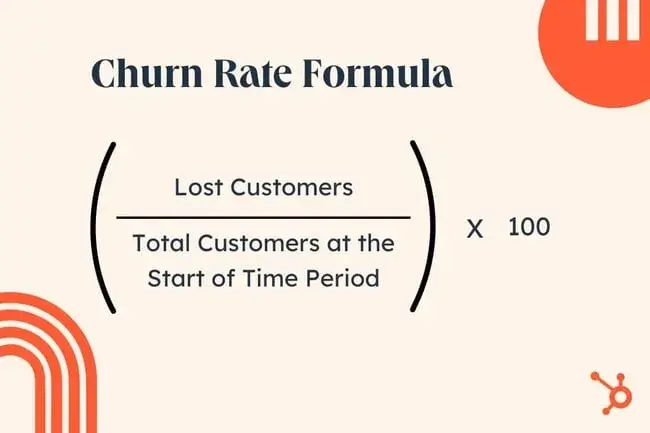Table of Contents
What is customer churn?
Customer churn is the percentage of customers who stopped using your company's product or service during a certain timeframe. These churned customers may leave for a competitor or stop using your offering without an alternative.
Why is tracking customer churn important?
You may be wondering why it‘s necessary to track churn rate. Naturally, you’re going to lose some customers here and there. Five percent doesn't sound too bad, right?
Well, knowing your churn rate can help you make smarter decisions. I’ll cover some notable benefits below.
Churn ends up costing you more.
Acquiring a new customer costs more than retaining an existing one. In fact, an increase in customer retention of just 5% can create at least a 25% increase in profit. That’s because returning customers spend 67% more on your company's products and services.
Your company spends less time and money to acquire new customers. You don‘t need to convince an existing customer to select your company over competitors because they’ve already made that decision.
Churn has a negative impact on brand image.
According to Zendesk, 3 out of 4 customers say that a bad customer experience makes or breaks their day. Beyond that, unhappy customers are likely to churn and complain. Not only will you lose sales, but your customers can easily give poor ratings, which causes a decline in your brand value.
Churn rates can help you identify customer pain points.
As a business, you’re tweaking your product and operations regularly. While many of these changes are for the better, some may have unintended consequences on the customer experience.
So, if you see a spike in churn after a change has been implemented, you can take note. You may need to implement another change or reverse course if a new development has angered your customers.
Customer Churn: Essential How-Tos
Now that you know why churn matters, how do you actually calculate it? Below, I’ll explain how to use the churn formula and how to turn your calculation into action.
How to Calculate Churn
You can calculate churn rate by dividing the number of customers you lost during that time period by the number of customers you had at the beginning of that time period.

For example, let’s say I start my quarter with 400 customers and end with 380. My churn rate is 5%, meaning that I lost 5% of my customers.
Obviously, your company should aim for a churn rate that is as close to 0% as possible. In order to do this, you should know your churn rate at all times and treat it as a top priority.
In this example, I calculated the churn rate as the percentage of customers lost that quarter. Depending on the industry, there are three ways to check your churn rate: monthly, quarterly, or annually. Most industries calculate their churn rate annually, while subscription-based businesses, such as Software as a Service (SaaS) providers, frequently measure their churn rate monthly.
It‘s ideal to have a churn rate of 5% or below. However, for SaaS businesses, it’s normal to have an average of 7.5%. A churn rate of 10% or higher should serve as a red flag that something needs to change in your client experience.
How to Monitor Churn Over Time
It’s useful to analyze your churned customers to understand why they leave. This data will help determine which metrics are associated with a high churn risk. You can also monitor customer service metrics such as average customer engagement, client lifetime value, and customer acquisition expenses.
Look at how and when churn occurs in a customer's lifetime with your company, and use that data to put into place preemptive measures. The more data you gather, the more trends you can identify over time so you can increase your customer retention efforts.
In general, your churn rate should be consistent overall, so if you see some significant changes, it could be a sign of trouble or a need for more research into why clients are disappearing.
How to reduce churn?
You can help reduce your customer churn and sustain it in several ways.
Rather than simply focusing on offering incentives to customers who are considering churning, it could be even more beneficial to pool your resources into your loyal, profitable customers. Or, instead of waiting to connect with your customers until they reach out to you, try a more proactive approach. Communicate with them all the perks you offer and show them you care about their experience, and they'll be sure to stick around.
For more tips, check out this post on how to reduce customer churn.
Managing Customer Churn
As I’ve said above, tracking your churn rate is essential. However, this metric won’t do you any good unless you make changes based on these insights. If your new data policy caused high churn, you should reevaluate your choice. If a change in your formula led to drop-off, you may need to change your recipe.
In addition to tracking churn, I recommend collecting regular feedback from your customers. That includes asking users why they left your business. You can use this information to investigate and find crucial consumer touchpoints that lead to churn.
Now, take what you’ve learned and turn customers from churn risks into advocates.
Editor's note: This article was originally published in November 2018 and has since been updated for comprehensiveness.
Customer Retention
.png?width=112&height=112&name=Image%20Hackathon%20%E2%80%93%20Vertical%20(85).png)

.png)
-2.png)
![7 Customer Acquisition Challenges You Might Face This Year [New Data]](https://53.fs1.hubspotusercontent-na1.net/hubfs/53/customer%20acquisition%20%20(1).webp)





![7 Secrets for Getting Repeat Customers That Stick Around [Consumer Data]](https://53.fs1.hubspotusercontent-na1.net/hubfs/53/repeat-customers.jpg)

